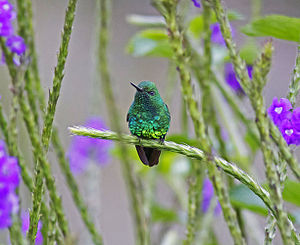Garden emerald hummingbird
| Garden emerald hummingbird | ||||||||||
|---|---|---|---|---|---|---|---|---|---|---|

Garden emerald hummingbird ♂ |
||||||||||
| Systematics | ||||||||||
|
||||||||||
| Scientific name | ||||||||||
| Chlorostilbon assimilis | ||||||||||
| Lawrence , 1861 |
The garden emerald hummingbird or garden hummingbird ( Chlorostilbon assimilis ) is a species of bird from the hummingbird family (Trochilidae) that is found in southwest Costa Rica and Panama . The IUCN assesses the population as Least Concern . The species is considered to be monotypical .
features
The garden emerald hummingbird reaches a body length of about 7.8 to 8.5 cm with a weight of about 3.0 to 4.1 g. The male is dark metallic green on top with narrow lines of dull, sparkling feathers on the reins and the adjacent base of the beak. The tail covers are bluish green, the tail bluish black, with the central control feathers having a bluish green sheen. The wings are tinted dark, pale purple and a little lighter green in the upper area, occasionally it has a blue shimmering tint and white tufts of thighs. The iris is dark brown, the beak black, the legs dark black. The female is light metallic green to bronze green on the upper side, often with bluish green upper tail-coverts. The tail is blue-black, with the central control feathers being a matt metallic green. Two of the three outer control springs are speckled with light gray. The wings are colored like the male. The reins and the upper ear covers are dark. Behind the eye is a white to grayish white stripe . The underside is pale gray. Often the legs are black. Young birds are similar in color to the females, but are a little darker on the underside. But you quickly develop an adult dress.
Behavior and nutrition
The garden emerald hummingbird gets its nectar from scrub and trees such as the real guava , but also from many smaller plants such as Combretum farinosum . He often visits decorative hedges close to the ground in cities or coffee plants in bloom. Furthermore, it feeds on insects, which it collects from branches or tree trunks. As a trapliner, it flies to specific flowers in quick succession.
Reproduction
Little is known about the reproduction of the garden emerald hummingbird. A female from Panama was observed ready to lay eggs in January. Nests were discovered in November and January. In the middle of March, birds in breeding mood were observed. The nest description and the rearing of the brood have not yet been described, but it is assumed that this is similar to that of the fork-tailed emerald hummingbird .
Vocalizations
His singing has not yet been described.
distribution and habitat
The garden emerald hummingbird likes the edges of forests, hedges around open fields, thickets along rivers, areas with scrub and gardens. Most of the reports come from the coasts of the lowlands and mountain foothills. In Panama it occurs at altitudes up to 1200 meters, in Costa Rica up to 1500 meters.
migration
The garden emerald hummingbird appears to migrate between the mainland in Panama and the Pearl Islands . The species has also been observed on eight other islands besides the Pearl Islands, but it is not known whether they breed there or whether they are resident birds there.
Etymology and history of research
The garden emerald hummingbird was first described in 1861 by George Newbold Lawrence under the scientific name Chlorostilbon assimilis . The type specimen came from the viceroyalty of New Granada and was collected by James McLeannon . It was John Gould who introduced the new genus Chlorostilbon in 1853 . "Chlorostilbon" is made up of the Greek words "chlōros χλωρός " for "green" and "stilbōn στίλβων " for "shining". The Greeks gave Mercury the nickname Stilbōn, which is due to the verb "stilb" for "blink". The species name "assimilis" is the Latin word for "similar, equal". Lawrence alluded to the resemblance to the West Indian emerald hummingbird ( Chlorostilbon melanorhynchus Gould , 1860).
literature
- Josep del Hoyo , Nigel James Collar, Guy Maxwell Kirwan, Peter Boesman in: Josep del Hoyo, Andrew Elliott, Jordi Sargatal , David Andrew Christie , Eduardo de Juana: Garden Emerald (Chlorostilbon assimilis). In: Handbook of the Birds of the World Alive . Lynx Edicions, Barcelona.
- James A. Jobling: Helm Dictionary of Scientific Bird Names . Christopher Helm, London 2010, ISBN 978-1-4081-2501-4 .
- George Newbold Lawrence . Catalog of a collection of birds, made in New Grenada, by James McLeannon, Esq of New York, with notes, and descriptions of new species Part I . In: Annals of the Lyceum of Natural History of New York . tape 7 , 1861, p. 288-302 ( biodiversitylibrary.org ).
- John Gould: A monograph of the Trochilidæ, or family of humming-birds . tape 5 , delivery 5. Taylor and Francis, London 1853 ( biodiversitylibrary.org ).
- Frederick Herschel Waterhouse: The dates of publication of some of the zoological works of the late John Gould, FRS RH Porter, London 1885 ( biodiversitylibrary.org ).
Web links
- Chlorostilbon assimilis inthe IUCN Red List of Threatened Species 2018.2. Listed by: BirdLife International, 2016. Retrieved April 17, 2019.
- BirdLife International: Species Factsheet - Garden Emerald ( Chlorostilbon assimilis ) . Retrieved April 17, 2019.
- Videos, photos and sound recordings for Garden Emerald (Chlorostilbon assimilis) in the Internet Bird Collection
- Garden emerald hummingbird ( Chlorostilbon assimilis ) at Avibase; accessed on April 17, 2019.
- Chlorostilbon assimilis in the Integrated Taxonomic Information System (ITIS). Retrieved on 2019-04-17.
- xeno-canto: sound recordings - garden emerald hummingbird ( Chlorostilbon assimilis )
- Garden Emerald (Chlorostilbon assimilis) in the Encyclopedia of Life . Retrieved April 17, 2019.
Individual evidence
Remarks
- ↑ According to Frederick Herschel Waterhouse p. 47, Plate 355 appeared as part of Delivery 5 from 1853. Here Gould assigned the Chlorostilbon prasinus , a synonym for the blue-tailed emerald hummingbird ( Chlorostilbon mellisugus ( Linnaeus , 1758)) to the genus.
